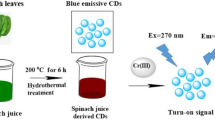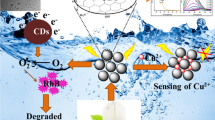Abstract
Green synthesis of highly soluble and photostable carbon dots (CDs) through hydrothermal treatment of highly carbonaceous pomegranate leaf extract has been demonstrated. Since the oxygen-containing functional groups of CDs can interact with nitro groups of 2,4,6-trinitrophenol (TNP), the PL intensity of the as-prepared CDs was significantly quenched in the presence of 2,4,6-TNP; this phenomenon was ascribed to the formation of a ground state complex caused by the inner filter effect mechanism. The developed sensing platform displayed a linear curve with a detection limit of 0.0620 μM and regression coefficient of 0.99616 for different concentrations of 2,4,6-TNP ranging from 0 to 120.0 μM.
Graphical abstract





Similar content being viewed by others
Data availability
The datasets generated during and/or analyzed during the current study are available from the corresponding author on reasonable request.
References
D.K. Singha, S. Bhattacharya, P. Majee et al., Optical detection of submicromolar levels of nitro explosives by a submicron sized metal-organic phosphor material. J. Mater. Chem. A (2014). https://doi.org/10.1039/c4ta05014b
M. Chatterjee, P. Nath, S. Kadian et al., Highly sensitive and selective detection of dopamine with boron and sulfur co-doped graphene quantum dots. Sci. Rep. (2022). https://doi.org/10.1038/s41598-022-13016-4
S. Kadian, G. Manik, A highly sensitive and selective detection of picric acid using fluorescent sulfur-doped graphene quantum dots. Luminescence (2020). https://doi.org/10.1002/bio.3782
S.S. Nagarkar, A. Desai, v., Samanta P, Ghosh SK, Aqueous phase selective detection of 2,4,6-trinitrophenol using a fluorescent metal-organic framework with a pendant recognition site. Dalton Trans. (2015). https://doi.org/10.1039/c5dt00397k
S.S. Nagarkar, A. Desai, v., Ghosh SK, Engineering metal-organic frameworks for aqueous phase 2,4,6-trinitrophenol (TNP) sensing. CrystEngComm (2016). https://doi.org/10.1039/c6ce00244g
V.D. Dao, P. Kim, S. Baek et al., Facile synthesis of carbon dot-Au nanoraspberries and their application as high-performance counter electrodes in quantum dot-sensitized solar cells. Carbon NY (2016). https://doi.org/10.1016/j.carbon.2015.09.023
N.M. Hoang, N.T.B. Ngoc, L.T.P. Thao et al., Experimental synthesis of dual-emission carbon dots: The role of reaction temperature. Inorg. Chem. Commun. (2023). https://doi.org/10.1016/j.inoche.2022.110301
N.A. Tran, N.T. Hien, N.M. Hoang et al., Carbon dots in environmental treatment and protection applications. Desalination 548, 116285 (2023)
S. Kadian, B.D. Arya, S. Kumar et al., Synthesis and application of PHT-TiO2 nanohybrid for amperometric glucose detection in human saliva sample. Electroanalysis (2018). https://doi.org/10.1002/elan.201800207
A. Kalkal, R. Pradhan, S. Kadian et al., Biofunctionalized graphene quantum dots based fluorescent biosensor toward efficient detection of small cell lung cancer. ACS Appl. Bio. Mater. (2020). https://doi.org/10.1021/acsabm.0c00427
S. Kadian, S.K. Sethi, G. Manik, Recent advancements in synthesis and property control of graphene quantum dots for biomedical and optoelectronic applications. Mater. Chem. Front. 5, 627–628 (2021)
A. Kalkal, S. Kadian, R. Pradhan et al., Recent advances in graphene quantum dot-based optical and electrochemical (bio)analytical sensors. Mater. Adv. 2, 5513–5541 (2021). https://doi.org/10.1039/D1MA00251A
S. Kadian, G. Manik, Sulfur doped graphene quantum dots as a potential sensitive fluorescent probe for the detection of quercetin. Food Chem. (2020). https://doi.org/10.1016/j.foodchem.2020.126457
S. Kadian, N. Chaulagain, N.N. Joshi et al., Probe sonication-assisted rapid synthesis of highly fluorescent sulfur quantum dots. Nanotechnology 34, 30LT01 (2023). https://doi.org/10.1088/1361-6528/acd00a
S. Kadian, G. Manik, N. Das, P. Roy, Targeted bioimaging and sensing of folate receptor-positive cancer cells using folic acid-conjugated sulfur-doped graphene quantum dots. Microchim. Acta (2020). https://doi.org/10.1007/s00604-020-04448-8
A. Barati, M. Shamsipur, H. Abdollahi, Hemoglobin detection using carbon dots as a fluorescence probe. Biosens. Bioelectron. (2015). https://doi.org/10.1016/j.bios.2015.04.073
A. Sachdev, P. Gopinath, Green synthesis of multifunctional carbon dots from coriander leaves and their potential application as antioxidants, sensors and bioimaging agents. Analyst (2015). https://doi.org/10.1039/c5an00454c
H. Huang, Y. Xu, C.J. Tang et al., Facile and green synthesis of photoluminescent carbon nanoparticles for cellular imaging. New J. Chem. (2014). https://doi.org/10.1039/c3nj01185b
A. Mewada, S. Pandey, S. Shinde et al., Green synthesis of biocompatible carbon dots using aqueous extract of Trapa bispinosa peel. Mater. Sci. Eng. C (2013). https://doi.org/10.1016/j.msec.2013.03.018
S. Kadian, G. Manik, A. Kalkal et al., Effect of sulfur doping on fluorescence and quantum yield of graphene quantum dots: an experimental and theoretical investigation. Nanotechnology (2019). https://doi.org/10.1088/1361-6528/ab3566
R. Kumar, J. Kumar, S. Kadian et al., Tunable ionic conductivity and photoluminescence in quasi-2D CH3NH3PbBr 3 thin films incorporating sulphur doped graphene quantum dots. Phys. Chem. Chem. Phys. 23, 22733–22742 (2021). https://doi.org/10.1039/D1CP03621A
S. Kadian, G. Manik, N. Das et al., Synthesis, characterization and investigation of synergistic antibacterial activity and cell viability of silver-sulfur doped graphene quantum dot (Ag@S-GQDs) nanocomposites. J. Mater. Chem. B (2020). https://doi.org/10.1039/c9tb02823d
U. Heredia-Rivera, V. Kasi, A. Krishnakumar et al., Cold atmospheric plasma-assisted direct deposition of polypyrrole-Ag nanocomposites for flexible electronic sensors. ACS Appl. Mater. Interfaces 15, 17078–17090 (2023). https://doi.org/10.1021/acsami.2c20798
S.A. Machekposhti, S. Kadian, L. Vanderwal et al., Novel hollow biodegradable microneedle for amphotericin B delivery. MedComm (Beijing) (2023). https://doi.org/10.1002/mco2.321
A. Kalkal, S. Kadian, S. Kumar et al., Ti3C2-MXene decorated with nanostructured silver as a dual-energy acceptor for the fluorometric neuron specific enolase detection. Biosens. Bioelectron. (2022). https://doi.org/10.1016/j.bios.2021.113620
N. Chaulagain, K.M. Alam, S. Kadian et al., Synergistic enhancement of the photoelectrochemical performance of TiO2 nanorod arrays through embedded plasmon and surface carbon nitride co-sensitization. ACS Appl. Mater. Interfaces 14, 24309–24320 (2022). https://doi.org/10.1021/acsami.2c02649
S. Kadian, N.K. Tailor, N. Chaulagain et al., Effect of sulfur-doped graphene quantum dots incorporation on morphological, optical and electron transport properties of CH3NH3PbBr3 perovskite thin films. J. Mater. Sci. 32, 17406–17417 (2021). https://doi.org/10.1007/s10854-021-06272-z
A. Krishnakumar, S. Kadian, U. Heredia Rivera et al., Organ-on-a-chip platform with an integrated screen-printed electrode array for real-time monitoring trans-epithelial barrier and bubble formation. ACS Biomater. Sci. Eng. (2022). https://doi.org/10.1021/acsbiomaterials.2c00494
A. Krishnakumar, R.K. Mishra, S. Kadian et al., Printed graphene-based electrochemical sensor with integrated paper microfluidics for rapid lidocaine detection in blood. Anal. Chim. Acta. 1229, 340332 (2022). https://doi.org/10.1016/J.ACA.2022.340332
Z. Li, S. Kadian, R.K. Mishra et al., Electrochemical detection of cholesterol in human biofluid using microneedle sensor. J. Mater. Chem. B (2023). https://doi.org/10.1039/D2TB02142K
Acknowledgments
Authors thankfully acknowledge the staff of the Institute Instrumentation Centre, IIT Roorkee for providing access to advanced characterization facilities.
Author information
Authors and Affiliations
Corresponding author
Ethics declarations
Conflict of interest
On behalf of all authors, the corresponding author states that there is no conflict of interest.
Additional information
Publisher's Note
Springer Nature remains neutral with regard to jurisdictional claims in published maps and institutional affiliations.
Supplementary Information
Below is the link to the electronic supplementary material.
Rights and permissions
Springer Nature or its licensor (e.g. a society or other partner) holds exclusive rights to this article under a publishing agreement with the author(s) or other rightsholder(s); author self-archiving of the accepted manuscript version of this article is solely governed by the terms of such publishing agreement and applicable law.
About this article
Cite this article
Kadian, S., Kalkal, A., Jain, V. et al. Pomegranate leaf extract-based carbon dots for the selective detection of 2,4,6-trinitrophenol. MRS Communications 13, 885–891 (2023). https://doi.org/10.1557/s43579-023-00430-6
Received:
Accepted:
Published:
Issue Date:
DOI: https://doi.org/10.1557/s43579-023-00430-6




